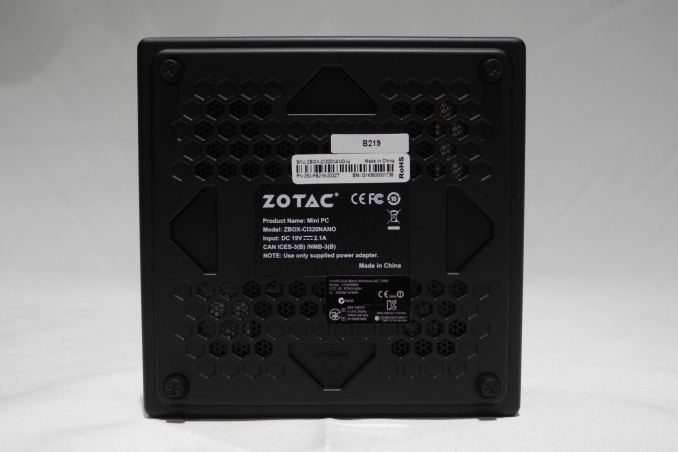Zotac ZBOX CI320 nano Review: A Fanless Bay Trail-M mini-PC
by Ganesh T S on January 6, 2015 10:00 AM ESTFinal Words
The Zotac ZBOX CI320 nano provided us with an opportunity to evaluate one of the more configurable, but passively cooled Bay Trail UCFF PCs in the market. Passively cooled systems are either very costly (particularly if they integrate powerful CPUs) or downright abysmal in performance (when they integrate the low-end / low-power CPUs such as the older Atoms). Zotac's offering with the ZBOX CI320 nano aims to strike a balance. $140 for a barebones configuration is quite good in this market segment. A fully loaded PLUS model, along with a pre-installed licensed version of Windows 8.1 is lesser than $260. It is frankly quite difficult to build such a compact and passively cooled system for that price on one's own.
One of the aspects we were worried about was thermal throttling, but the ZBOX CI320 nano surpassed our expectations. The chassis never got extremely hot (reaching only around 68 C, even after extended thermal stress with a couple of power viruses).
Pretty much the only downside of the unit is the relatively bad performance of Bay Trail when compared to Haswell. However, we shouldn't be really complaining for the price since the system seems to operate quite nicely for day-to-day use. The BIOS does need some work - particularly to ensure that cores are not in the max performance mode always in the default configuration. The SSD supplied with the PLUS model could be a bit better, but that is not an issue if the end-user buys a barebones configuration.
All in all, Zotac manages to deliver a very price-effective passive mini-PC in the ZBOX CI320 nano. Along with the ECS LIVA and the Zotac ZBOX CA320 nano in the market, the days of users having to spend an arm and leg for passively cooled systems with decent performance are history.











44 Comments
View All Comments
tential - Tuesday, January 6, 2015 - link
Yes for small machines like this the benchmarks are nice, but we need to have in the "Final Words" section some notes about their usage of this machine. Because the benchmark doesn't tell me if using Office/WebBrowsing feels alright or not.I'm VERY happy though that they started doing XBMC testing and to find this PC handles it perfectly. I'm curious to see how this would be priced without Windows so I could make it a dedicated XBMC machine.
jimbo2779 - Tuesday, January 6, 2015 - link
The price listed is already the price without the OS. It came with no OS and they had to install it themselves.bsd228 - Tuesday, January 6, 2015 - link
Windows with Bing is free for computers < $250. Basically they don't want to lose that business to Chrome.074geodude - Tuesday, January 6, 2015 - link
I'm starting to see a rise in popularity of low cost ($200 or less) miniPCs. At CES 2015 HP just announced the $180 Stream Mini. Gone will be the days of huge bulky desktops sitting on top of your desk. Now we'll have pocket-sized PCs at every monitor or TV that are capable of doing the daily tasks that most consumers need, like Office/web-browsing/streaming video.Solandri - Tuesday, January 6, 2015 - link
I would argue that most everyone already has a pocket-sized PC in their pocket - a smartphone. And all that's needed is a straightforward way to interface it with an external monitor/TV and keyboard/mouse any time you want to use a "PC" at a desk. Microsoft realizes this, which is why they are pushing Windows Phone and were pushing Windows RT. Intel realizes this, which is why they're concentrating on power savings and mobile processors (to take on ARM), rather than trying to push high-end performance.t.s. - Wednesday, January 7, 2015 - link
Agreed!Solandri - Tuesday, January 6, 2015 - link
That is exactly what the PCMark benchmarks on page 2 are for. They do a bunch of things which simulate home, office, or creative tasks and boil it down to a single number.http://en.wikipedia.org/wiki/PCMark
kmmatney - Tuesday, January 6, 2015 - link
The benchmarks I see are video encoding, compression, and some photoscan benchmark. Not really the same as using it as an office computer. It would also be nice to see these systems compared to a cheap desktop system with a Celeron or Pentium.silverblue - Wednesday, January 7, 2015 - link
I'd like to see a test that exposes the JPEG acceleration in Temash/Kabini; surely a valid usage scenario given the image-heavy nature of the Internet.Both the CI320 and CA320 confuse me. The former is hamstrung by having only one DIMM (Bay Trail supports dual channel at 1333MHz) and the latter has an astonishingly pedestrian CPU but actually costs more to buy. The top Mullins APU is far faster and wouldn't use any more power, so perhaps we'll see one in the not too distant future? Also, adding in an extra DIMM to the CI320 to test for any difference in performance would be very interesting.
Libertysyclone - Tuesday, January 6, 2015 - link
I see there is a spot for an IR sensor, is that built in? I didnt see it on the specs sheet